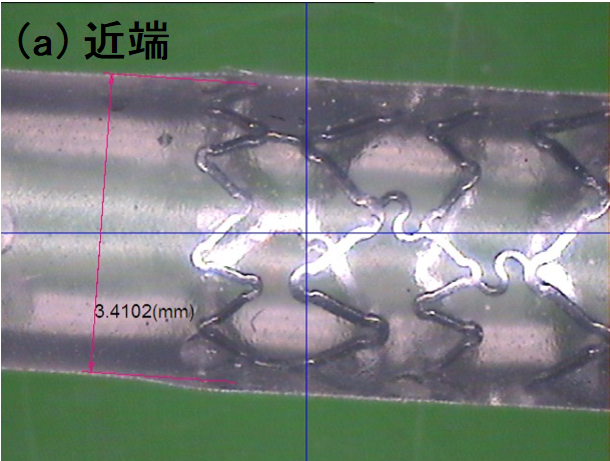
Zn-Cu支架的固有弹性回缩率为0.41±0.18%,316L SS支架的固有弹性回缩率为1.84±0.61%。这表明与316L SS支架相比,Zn-Cu支架可减少急性管腔丢失,有利于建立血流通道。体外试验测得的支架弹性回缩率与支架材料的弹性模量、支架设计有关。本实验中Zn-Cu支架和316L SS支架具有相同的壁厚、花型,因此实验结果可以反映Zn-Cu支架比传统材料支架在扩张后的管腔获得能力上可能具有一定优势。
图4-16 (a)、(b)、(c)分别展示了支架在模拟使用环境中释放后,近端、中段、远端三个代表性节段的贴壁情况。结果显示,支架释放后外表面紧贴模拟血管的内壁,无脱离、无翘起,支架形态完整、支架V型杆均匀展开。表明Zn-Cu支架能够对血管起到较好的支撑作用。
The inherent elastic shrinkage rate of Zn-Cu stent is 0.41±0.18%, and that of 316L SS stent is 1.84±0.61%. This indicates that compared with the 316L SS stent, the Zn-Cu stent can reduce acute lumen loss and help establish blood flow channels. The elastic retraction rate of the stent measured in vitro is related to the elastic modulus of the stent material and the design of the stent. In this experiment, the Zn-Cu stent and the 316L SS stent have the same wall thickness and pattern. Therefore, the experimental results can reflect that the Zn-Cu stent may have certain advantages in the ability to obtain the lumen after expansion compared with the traditional material stent.
Figure 4-16 (a), (b), (c) respectively show the attachment of the proximal, middle, and distal segments of the stent after being released in a simulated use environment. The results showed that the outer surface of the stent was tightly attached to the inner wall of the simulated blood vessel after the stent was released, without detachment and no uplifting, the stent shape was complete, and the stent V-shaped rods were evenly deployed. It shows that the Zn-Cu stent can play a better role in supporting blood vessels.